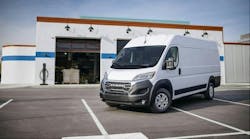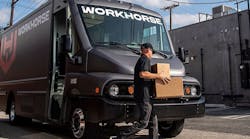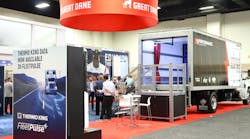Why is last-mile delivery so important, and what does the transportation equipment industry need to understand about the evolving supply chain? The key issues were discussed by a diverse panel of logistics experts in an educational session at this year’s Work Truck Show.
In a nutshell, thanks to e-commerce, home delivery continues to grow, outpacing GDP growth by two times, explained panel moderator Kevin Beaty, president of consulting firm YUNEV LLC. Indeed, the delivery segment is outpacing every other segment of trucking industry in terms of growth—including construction, government and utility.
Still, last-mile is considered one of the most expensive, inefficient and pollution-generating segments of transportation. It gets “ugly,” Beaty explained, because of failed deliveries, such as when the recipient is not home, and with each delivery, the amount of empty haul increases on the truck. Additionally, it’s difficult to plan efficient productive routes in low-density environments.
And it comes at a price. On-line commerce giant Amazon spent $47 billion in 2017 on last-mile and fulfillment centers, up 60 percent since 2009, he noted.
But the boom continues to attract companies that believe they can perform Delivery as a Service (DaaS) work. He points to the Postmates subscription delivery service and to What3words, using GPS mapping technology to promise delivery “straight to your lounge chair.”
“It might be more accurate to talk about this as an experiment, because not all of these experiments are proving successful, but they are proving to be educational,” Beaty said. “So as these start-ups launch, and sometimes fail, I wouldn’t write off the business model as much as I would say, ‘Hmm, I wonder what we’re learning from that. Why did it fail?’ What are we learning? Not ‘Oh, another one bites the dust.’”
More significantly, he suggests, “last-mile delivery is getting a close look from folks who traditionally really haven’t been part of this industry, (with) Ford, Amazon and many others looking in a very serious way at, ‘Wow, how do I leverage the internet, big data, the cloud, connectivity and maybe even autonomous vehicles to participate?’”
Electric vehicles are prime example of such solutions. Chris Nordh, senior director, Advanced Vehicle Technologies & Energy Products for Ryder System Inc calls EVs “the perfect last-mile vehicle.”
“You have this new class or new segment emerging, which is somewhere in between the commercial vehicles and the consumer vehicles,” Nordh said—but the question is just how quickly traditional OEMs will catch up and provide such a product, given the initial demand which is extremely small by OEM standards. A lot will depend on if and when local or state governments support sustainable transportation programs with incentives.
“Are we there yet, from an unincentivized perspective? Probably not. But from a technology perspective, what electric vehicles offer is basically that they’re niche: They love stop-and-go; they do not like highways,” Nordh said. “And so you have a competing product, in gasoline or diesel vehicles, which love the highway and hate stop-and-go. From a technology perspective, this last-mile segment is perfect for EVs, and so it becomes a question of when.
“So in California, you’re going to start seeing it happening, and in New York, Chicago and the cities that are taking very proactive approaches on creating grants. That is going to create the right amount of scale in order for these companies to be able to now create a product that is financially viable for the rest of the country as well. How long is that going to take? It’s certainly going to take quite a few years, but you have a specific industry that is going to catapult the EV probably more so than the consumer spaces.”
But as John Formisano, an advisor with Motus Ventures, a seed stage venture capital fund and business accelerator, pointed out: “You can be too early with technology.”
He noted that in his time at FedEx the company deployed EVs for delivery in Europe and the US, but the program was premature because batteries were too expensive. He anticipates a continued shift to smaller vehicles for package delivery, such as going from Class 6 trucks to Sprinters or even smaller vehicles, carrying fewer packages but in support of on-demand delivery.
“Vehicles are going to get smaller, the nature of delivering will change, and that’s where EVs will have their first traction,” Formisano said. “As vehicles get smaller, EVs start to make more sense. When you take the capitol cost out of it, EVs are cheaper to operate. So as prices come down, and they can go farther, maybe enhanced with some charging motors on EV, we will see more of these going forward.”
But, he noted – touching on Beaty’s point about commercial versus consumer quality – delivery vehicles must be robust enough for commercial applications.
“There’s a big difference when you look at these electric golf carts, or expanded golf carts, as opposed to something that was built to run 20 hours a day, to haul people on a college campus, or whatever the mobility application happens to be,” Formisano said. “So vehicles will need to be designed to be much closer to commercial spec.”
Still, the trend to smaller vehicles – and, in turn, electrification – is already happening, added Ryder’s Nordh.
“We’re seeing a shift in the types of vehicles our customers are wanting to lease from us, all the way from the top. So from the sleeper tractor, we’re seeing a lot more demand for day cabs … because they’re redefining their distribution networks,” he said. “So you take that one step further, and now you’re putting smaller distribution centers, or fulfillment centers, inside of cities. So now they’re going from day-cab tractors eventually down to straight trucks, and then from there, they’re moving with vans and Sprinters, as an example, and there are plenty of others out there.”
And Nordh agreed with Beaty’s suggestion that trying and failing has benefits, certainly compared to waiting on the sideline.
“I haven’t found anybody who’s doing last-mile delivery very profitably, but you can’t afford not to be there to learn from experience. And it comes multiple ways, this redefining of transportation networks and distribution models, down into vehicles and electrification. It’s an experiment,” he said. “You can’t sit still and wait for everything to prove itself out. You have to get in there and start learning immediately.”
And will autonomous vehicles have a niche in the last-mile segment?
Nordh notes that Ryder already specs advanced safety technology such as lane departure and collision avoidance for its fleet.
“It’s extremely interesting to see the evolution of the technology. But you’re going to see a slower adoption, based on business-model changes that need to take place in order to take those types of technologies into the fleets,” he said. “I see that as a broader horizon in commercial applications than electrification.”
As Formisano added, an urban environment is the most challenging for autonomous vehicles, with more intersections and pedestrian interactions than the open highway. But he also explained that technology is being developed by a startup company, Scotty Labs, to allow remote drivers to take control of autonomous vehicles for the more challenging segments of a delivery—but the feasibility of such technology will depend on “enablers” such as the coming 5G communications platform. (In late March, Scotty Labs announced a $6 million seed round led by a Google-backed early-stage venture fund.)
Similarly, the much-talked-about aerial drone delivery technology is currently undergoing testing (and was demonstrated at the Work Truck Show), but the Teamsters Union is challenging such systems in labor agreement negotiations. (Representatives for Amazon and UPS were scheduled to participate in the last mile discussion but backed out.)
“It’s a very timely and real issue within the industry at the moment,” Beaty said.
But as Formisano explained, a drone can do better than a delivery truck over twisting roads to a particular location—that’s where the technology saves miles and time.
“If you go back to what made FedEx successful way back in the day, it was that the value per pound of the package exceeded the transportation costs, so that’s where the drones are going to make the most success – where the value per package that you’re carrying with this drone exceeds the cost of the operation and use of that drone,” he said.
Still, how does an established commercial vehicle builder (whether trucks, trailers, or work truck bodies) decide between getting left behind or going broke by getting too far ahead of the curve on this evolving market for equipment?
“It’s very tough to invest significant amounts of money in products that, over time, will generate less parts and less labor, so I get the dilemma,” said Nordh. “I don’t want to say it’s the chicken or the egg, that’s almost too cliché. But coming out with products that serve that last mile, which most traditional OEMs have a vehicle that looks like it, that is the size of it, but then adding on that cost-effective EV system with a pathway of increasing miles in order to grab a larger and larger stake of that market, is certainly what’s needed from the traditional OEMs.
“Right now, we’re seeing very limited numbers of vehicles that satisfy those kinds of needs. There are a lot of conversions, and with conversions also comes inefficiencies. Really, what we’re looking for, for an electric vehicle, is it needs to be built from the ground up as an electric vehicle with batteries in mind, which, as an example, Tesla was the first one to do in the consumer space. So we need to see that exact same scenario happen in a commercial space.”
Formisano sees opportunities for smaller, specialty equipment builders to take advantage of the evolving marketplace.
“This is a great opportunity for up-fitters to create, in a vehicle of whatever brand, the capability for some cold storage, because some of your packages may need to be temperature-controlled,” he said. “So upfitters are going to have an opportunity to install this equipment. The whole truck doesn’t have to be refrigerated now, maybe just a small portion of that vehicle, because it’s going to serve many purposes as it makes its last-mile delivery through the neighborhood.”









